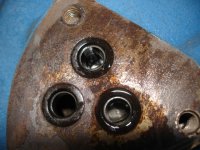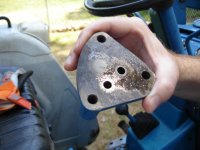I used the term pressure control valve, while your using pressure relief valve.
After thinking about this more, it may be possible that it is not working OK. Sorry if this is going to be confusing by I don’t have access to my tractor manuals right now – I’m babysitting my mother overnight at her assisted living facility.
I’m going to leave out the power steering circuit out of this for now.
Going by my memory, hydraulic fluid comes out of the hydraulic pump and flows to the diverter valve on the right side of the transmission housing. With the diverter valve set to flow to the FEL, hydraulic fluid goes through the FEL control valve and back to the diverter. It then flows to the 3pt housing where it will either be used to operate the 3pt or dumped into the reservoir.
When you are not using either the FEL or 3pt, the control valves for both are just bypassing fluid to the reservoir without an significant pressure.
There is a pressure relief valve in the diverter valve so if the FEL is being asked to exceeded its designed parameters the fluid will be dumped past the FEL circuit and head to the 3pt housing.
There is a pressure relief valve and flow control valve in the 3pt circuit so if the 3pt is asked to exceed its designed parameters the fluid will be dumped past the 3pt circuit and head to the reservoir.
Now your running the tractor down the field road and everything is fine. The pump is pumping fluid and since neither the FEL nor 3pt is being utilized no significant pressure is being produced.
Now you start to lift with the FEL. The FEL control valve directs fluid to the arm lift cylinders and pressure builds to push those cylinders. As long as the pressure generated does not exceed the limit of the diverters relief valve everything is good. Depending on the load in the FEL, maybe you’re generating 500psi, 1000psi or 2000psi – up to whatever the diverter relief valve is set to.
So your pump can generate whatever fluid pressure is necessary and your FEL circuit is working fine.
Now we get to the 3pt circuit. When you move the control valve to lift rather then duping back to the reservoir it directs fluid to the lift piston but up to the design limit by the pressure relief valve that your mechanic already replaced. As long as the piston seal (also just replaced) is not leaking pressure should build up to the limit set by the pressure relief valve.
So I surmise that either the new seal is leaking, some of the damaged original lift piston seal got into the new pressure relief valve preventing it from closing, or the new pressure relief valve has not been set to the correct operating pressure. And for that you are going to need your newly ordered pressure guage.


